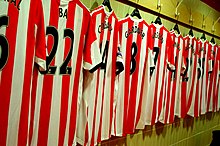Jersey (sport)


A jersey ( French tricot to tricoter , knitting ') or dress is in sports a mostly colored sport shirt. In team sports it is often provided with the athlete's number and name and is designed in the colors of the team or the club . Jerseys are worn by the athlete during the competition; they therefore have the character of work clothes , especially in professional sports . They usually refer to a piece of clothing with sleeves.
In team sports, the entire team usually wears uniform jerseys. Exceptions are, for example, the goalkeepers of ball sports such as handball or soccer , who wear a special goalkeeper jersey. In popular top-class sport, jerseys are also often advertising media (jersey advertising ). In addition to the actual sporting activities, they are also sold as fan devotional items for merchandising purposes. As a result, in addition to its pragmatic clothing function , the jersey is a bearer of symbols in several ways .
In cycling jerseys are used to the leaders of the respective ratings highlight, for example in the Tour de France : the yellow jersey for the overall leader, the green jersey for the leader in the points classification , the white jersey for the leader in the youth classification and Dotted Jersey for the leader in the mountain classification .
Jersey color
Since the stimulus intensity also accelerates the optical reaction speed in the case of selection reactions , it has been tested both in the laboratory and in the cinema using football films whether and to what extent a strong optical stimulus (bright jersey color clearly different from the background) also promotes the reaction speed in sports games. The tests so far make it clear that it is above all the glittering jerseys (e.g. in gold) that accelerate the reaction time. Dark away jerseys, on the other hand, slow down reaction times in sports games.
history
The first sports jerseys were made at the beginning of the 19th century. With the gymnastics movement of sport father Jahn from 1807 gymnastics became a popular sport among the population. The first sports clubs developed and with them the need to be able to visually differentiate between the players of different teams. For this purpose, the shirts of the team members were dyed in the colors of the clubs and provided with club logos. The individual players could be better distinguished by sewing on player numbers.
The first modern Olympic Games , which took place in 1896 , gave another reason for the development of special sportswear .
Since the 1970s, the jersey was first in football also used to the sponsors to promote the team. In the Bundesliga season 1973/74, the club Eintracht Braunschweig wanted to absorb the losses caused by missing spectators. The advertising on the jerseys already prevailed in the coming Bundesliga season. Today the jerseys of almost all professional athletes are provided with advertising logos.
Today, jerseys are also finding their way into clothing fashion . Second-hand shops in particular offer original goods from various sports. In addition, jerseys are also produced from the outset as a fashion item without being intended to be worn in sports competitions. The lettering and number on the back are then often only decorations or references to the brand.
material
Until the beginning of the 1970s, jerseys were mostly made of cotton , later often made of polyamide , nowadays jerseys are made of polyester in the form of microfibres . Environmentally sustainable products are made from bamboo, for example at the British football club Forest Green Rovers , since the microplastics that are created when plastic products break down represent an enormous environmental burden.
See also
Web links
Individual evidence
- ↑ Arnd Krüger (2012): jersey color. Competitive sports 42 (2) 40
- ↑ J. Causer; AP McRobert; AM Williams (2013): The effect of stimulus intensity on response time and accuracy in dynamic, temporally constrained environments. Scand J Med Sci Sports 23 (5): 627-634
- ↑ Sportnews Hameln: Sportswear - the history of the jersey ( Memento from January 1, 2013 in the Internet Archive )
- ↑ Bayern 2: The History of Football Sponsorship ( Memento from July 2, 2012 in the Internet Archive ). Retrieved September 12, 2012.